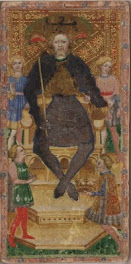 Eight hundred pages of the fourth century Codex Sinaiticus, the oldest Bible in the world (however it may sound like a disease...), are now viewable at http://www.codexsinaiticus.org/en/
Eight hundred pages of the fourth century Codex Sinaiticus, the oldest Bible in the world (however it may sound like a disease...), are now viewable at http://www.codexsinaiticus.org/en/Four scribes wrote it in Greek at about the time of the Roman emperor Constantine the Great in the fourth century. Its pages are vellum parchment made from the skins of donkeys or antelopes, preserved in the dry desert air of the oldest Christian monastery, the fourth century Monastery of St Catherine at the foot of Mount Sinai in Egypt.
The Codex is important outside of its religious context, in that it's a step in the evolution from scrolls to books. "The parchment was arranged in little multi-page booklets called quires, which were then numbered in sequence. It is thought to be the oldest, large, bound book to have survived," according to an article in The Independent.
To Christian scholars, it offers key insights into which ancient religious texts were brought together in the unit we now know as the Bible. In earlier centuries there were all manner of documents in scroll form of gospels, epistles and other Christian writings. As time went by, some were judged to be authoritative and included in the canon; others were deemed to be apocryphal or errant. The Codex Sinaiticus as it survives is incomplete – originally it would have been about 1,460 pages long – but it includes half of the Old Testament, all the New Testament, and two early Christian texts not found in modern Bibles. It offers the first evidence of the content and the arrangement of the Bible, and includes numerous revisions, additions and corrections made to the text between the 4th and 12th centuries, making it one of the most corrected manuscripts in existence, showing how the text of the Bible was transmitted from generation to generation down through the ages.That article also notes that there were quite a few alterations between this ancient version of the Bible and what we now consider canonical. It includes the Epistle of Barnabas and the Shepherd of Hermas, for instance. And the Gospel of Mark, widely held to be the oldest of the gospels, ends abruptly with the crucifixion - no resurrection.


No comments:
Post a Comment